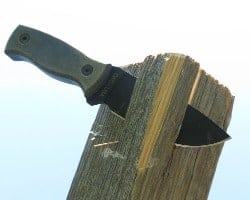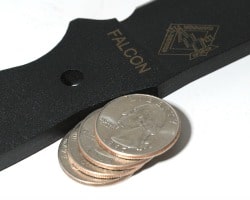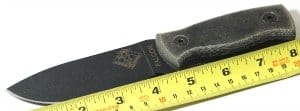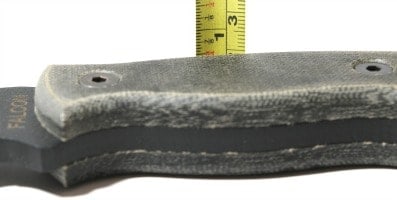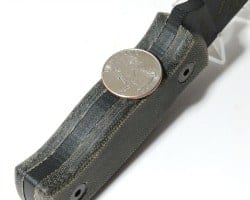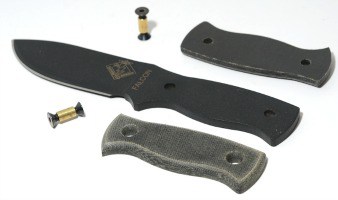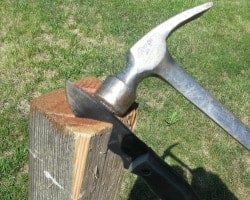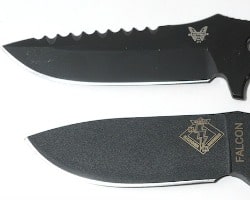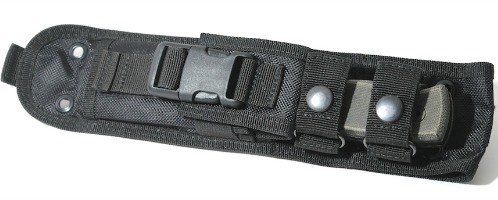One particular blade that has been flying under the radar for several years now is the Falcon from Ontario Knife Company (OKC), and
In reality, the Ranger Falcon'sunique skill set makes it one hell of a tool. For starters, the
SKIP AHEAD
Spring Forward
The Falcon's wingspan is eight inches and she weighs 10 ounces. The four-and-a-quarter inch long cutting blade is made of 5160 spring steel which has some advantages. In addition to being short but thick, the steel of the blade, as a spring steel, contains some molybdenum to give it the “spring” it needs to return to its original shape after being deflected even beyond 45 degrees. However, being so thick and short, the blade will be next to impossible to bend without some significant additional leverage help from a pipe or other cheater bar. Further, the 5160 has been tempered with a Rockwell number much below common survival knife hardness. At 53-55 HRC, the blade is noticeably softer than the usual 60ish Rockwell hardness of most survival iron. HRC is the a Rockwell hardness determined by using a Carbide indenter, hence the C.
Another contradiction is the handle, but where to start. The Micarta grip is almost as wide as it is thick, and it is thick. But it is also noticeably shorter than what you expect on a knife this beefy. My mitts are on the large size, leaning more to the XL than the M, and the scales on the Falcon fill my hand with not a bit of grip to spare. The question is whether or not you need a grip with a bit to spare. Every other fixed blade in my shed gives me at least half an inch of grip beyond my hand, often more, but not the Falcon. Instead, this bird has more in common with a sub-compact pistol grip that a traditional knife handle so much of the same logic applies when assessing the grip-fit of the knife.
Also Read: Fallkniven A1 Survival Knife Review
Where the Falcon shines is in brute force jobs, and panic-driven violence. As a survival blade, the Falcon is different from other blades
The flat grind blade keeps the sides flat as they converge on the cutting edge. Flat grinds are simple, strong, and easy to sharpen, but won’t cut as precisely as hollow grinds, nor ever become scary sharp. However, a dull flat grind blade can always be touched up with locally sourced rocks or steel.
The green Micarta scales attach with two eighth-inch hex head bolts on each side meeting at the middle in a threaded brass collar. The black powder-coated drop point blade is textured as well. Since the steel is coated under the scales, as it should be, potentially the grip could be paracorded if desired, but you would have to make creative use of the pair of small holes in the handle since that’s all you have to work with.
A finger choil accents the blade, but no jimping is found anywhere on the knife. The extra finger placement may help control the knife when out of sight inside some critter’s body cavity. But then again, hunting is not quite this knife’s forte, but it does belong on a hunting trip. The overbuilt Falcon is similar to the head of a hatchet, however quality wood cutters often have convex blade grinds to help prevent the clinching and binding in the wood. That’s why convex grinds are also known as axe grinds.
Battening is not a problem for the Falcon as long as you limit your wood diameter to beercan-size, unless of course you want to whittle
In many ways, the Falcon challenges the definition of a traditional survival knife. It is an unique combination o “if some is good, then more is better” and “less is more.” In a nutshell, the Falcon exceeds expectations by pushing the limits of knife measurements. While it is easy to discover limitations of this knife due to size, thickness, steel type, grind, and grip, it also opens up new windows into what is possible with a knife when one considers the break with tradition as an opportunity instead of a restriction. Like what, you might ask? Like about anything that you shouldn’t do with a knife, which if you think about it is a much longer list than what you should do. Can opener, shovel, chisel, prybar, scraper, wedge, pruner, punch, and hammer for example.
Hold On There
Gripping this knife is quite comfortable in any forward grip as well as a reverse grip with edge out (RGEO). And no matter how you hold it, you certainly don’t have to baby it. The softer steel of the blade will roll a little after repeated pounding, stabbing, jabbing, and hacking, but sharpens right up with little effort. While this steel and it’s particular tempering won’t set any sharpness records, it will perform as needed for all the duties that call for a thick short blade operated with a small grip. In fact, the mains strength of this knife is its strength. The flat grind preserves much material in the center of the blade making this little beast thicker in the middle than many knives are at their spine. As a wedge-shaped grind, it behaves much like a hatchet splaying apart wood like nobody’s business.
Also Read: Parry Blade Survival Knife Review
What do I want this knife for? Great question. I acquired it as part of a project I call the BASH Box. BASH as in Battle-Assault-Secure-Hide. Corny, I know, but still it demonstrates a proof of concept. Where the bugout bag leaves off, the BASH Box picks up.
Fly Like An Eagle
The Falcon occupies the rare but enviable intersection of minimal size and extreme strength. Small in stature but intense in muscle, the
Out in the open, the Falcon cuts as well as any other basic fairly sharp four-inch blade, yet fights with the skill and resolve of a much longer steel. Most survival scenarios do not require a battle blade to constantly mark its territory, but instead toe-the-line with domestic chores and KP duty. Which is exactly why I chose to cage the Falcon in my BASH Box. When the time comes to crack the O-ring seal on the box, I won’t be needing to fillet a fish or slice some tomatoes. No, I am going to count on the Falcon to do the heavy lifting and wet work. Whether Battle, Assault, Secure, or Hide the Falcon will rise to the occasion and slice, dice, dig, hack and stab its way to survival.
The Falcon’s Nest
Ahh, but the sheath. Since I consider the sheath a freebie on a ~$68 knife (street price), I won’t apologize for any sheath shortcomings. However, I don’t think the nylon fabric sheath is worthy of many complaints. As a tactical/survival knife cover, it plays the game well and answers many calls including supposedly MOLLE compatible (but on mine the spacing between webbing strips is not mil-spec and thus doesn’t line up with true MOLLE web ladders), sharpening stone compatible, tactical leg strap compatible, and it has not one but two snap straps (individually adjustable, I might add) securing the knife. No doubt the Kydex Krowd will want something else; something noticeably more durable and cool and I certainly don’t blame them.
In the end, the Falcon roosts where chaos reigns. Hunting is fine camouflage but in reality this bird is for fighting your way towards the future. We can all play the game Ontario’s PR department wants us to, but with a smirk or a smile, we can also agree that when the S really HTF, we will be well prepared with the Ranger Falcon even though it’s a, cough, cough, hunting knife.
All photos taken by Doc Montana


